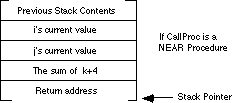
CallProc(i,j,k+4);Most Pascal compilers push their parameters onto the stack in the order that they appear in the parameter list. Therefore, the 80x86 code typically emitted for this subroutine call (assuming you're passing the parameters by value) is
push i
push j
mov ax, k
add ax, 4
push ax
call CallProc
Upon entry into CallProc, the 80x86's stack looks like that
shown below (for a near or a far procedure).
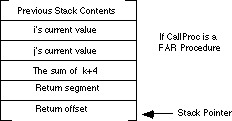
You could gain access to the parameters passed on the stack by removing
the data from the stack (Assuming a near procedure call):
CallProc proc near
pop RtnAdrs
pop kParm
pop jParm
pop iParm
push RtnAdrs
.
.
.
ret
CallProc endp
There is, however, a better way. The 80x86's architecture allows you to
use the bp (base pointer) register to access parameters passed
on the stack. This is one of the reasons the disp[bp], [bp][di], [bp][si],
disp[bp][si], and disp[bp][di] addressing modes use
the stack segment rather than the data segment. The following code segment
gives the standard procedure entry and exit code:
StdProc proc near
push bp
mov bp, sp
.
.
.
pop bp
ret ParmSize
StdProc endp
ParmSize is the number of bytes of parameters pushed onto the
stack before calling the procedure. In the CallProc procedure
there were six bytes of parameters pushed onto the stack so ParmSize
would be six. mov
bp, sp in StdProc. Assuming you've pushed three
parameter words onto the stack, it should look something like shown below: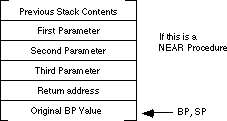
Now the parameters can be fetched by indexing off the bp
register:
mov ax, 8[bp] ;Accesses the first parameter
mov ax, 6[bp] ;Accesses the second parameter
mov ax, 4[bp] ;Accesses the third parameter
When returning to the calling code, the procedure must remove these parameters
from the stack. To accomplish this, pop the old bp value off
the stack and execute a ret 6 instruction. This pops the return
address off the stack and adds six to the stack pointer, effectively removing
the parameters from the stack. The stack contents when calling a far procedure are shown below:
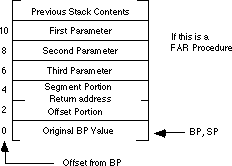
This collection of parameters, return address, registers saved on the
stack, and other items, is a stack frame or activation record.
When saving other registers onto the stack, always make sure that you save
and set up bp before pushing the other registers. If you push
the other registers before setting up bp, the offsets into
the stack frame will change. For example, the following code disturbs the
ordering presented above:
FunnyProc proc near
push ax
push bx
push bp
mov bp, sp
.
.
.
pop bp
pop bx
pop ax
ret
FunnyProc endp
Since this code pushes ax and bx before pushing
bp and copying sp to bp, ax
and bx appear in the activation record before the return address
(that would normally start at location [bp+2]). As a result,
the value of bx appears at location [bp+2] and
the value of ax appears at location [bp+4]. This
pushes the return address and other parameters farther up the stack as shown
below: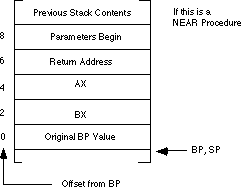
Although this is a near procedure, the parameters don't begin until offset
eight in the activation record. Had you pushed the ax and bx
registers after setting up bp, the offset to the parameters
would have been four:
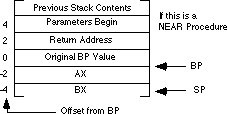
FunnyProc proc near
push bp
mov bp, sp
push ax
push bx
.
.
.
pop bx
pop ax
pop bp
ret
FunnyProc endp
Therefore, the push bp and mov bp, sp instructions
should be the first two instructions any subroutine executes when it has
parameters on the stack. [bp+6] can
make your programs very hard to read and maintain. If you would like to
use meaningful names, there are several ways to do so. One way to reference
parameters by name is to use equates. Consider the following Pascal procedure
and its equivalent 80x86 assembly language code:
procedure xyz(var i:integer; j,k:integer);
begin
i := j+k;
end;
Calling sequence:
xyz(a,3,4);
Assembly language code:
xyz_i equ 8[bp] ;Use equates so we can reference
xyz_j equ 6[bp] ; symbolic names in the body of
xyz_k equ 4[bp] ; the procedure.
xyz proc near
push bp
mov bp, sp
push es
push ax
push bx
les bx, xyz_i ;Get address of I into ES:BX
mov ax, xyz_j ;Get J parameter
add ax, xyz_k ;Add to K parameter
mov es:[bx], ax ;Store result into I parameter
pop bx
pop ax
pop es
pop bp
ret 8
xyz endp
Calling sequence:
mov ax, seg a ;This parameter is passed by
push ax ; reference, so pass its
mov ax, offset a ; address on the stack.
push ax
mov ax, 3 ;This is the second parameter
push ax
mov ax, 4 ;This is the third parameter.
push ax
call xyz
On an 80186 or later processor you could use the following code in place
of the above:
push seg a ;Pass address of "a" on the
push offset a ; stack.
push 3 ;Pass second parm by val.
push 4 ;Pass third parm by val.
call xyz
Upon entry into the xyz procedure, before the execution of
the les instruction, the stack looks like shown below: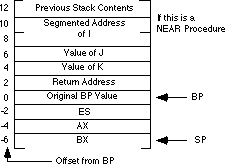
Since you're passing I by reference, you must push its address onto the
stack. This code passes reference parameters using 32 bit segmented addresses.
Note that this code uses ret 8. Although there are three parameters
on the stack, the reference parameter I consumes four bytes
since it is a far address. Therefore there are eight bytes of parameters
on the stack necessitating the ret 8 instruction.
Were you to pass I by reference using a near pointer rather than a far pointer,
the code would look like the following:
xyz_i equ 8[bp] ;Use equates so we can reference
xyz_j equ 6[bp] ; symbolic names in the body of
xyz_k equ 4[bp] ; the procedure.
xyz proc near
push bp
mov bp, sp
push ax
push bx
mov bx, xyz_i ;Get address of I into BX
mov ax, xyz_j ;Get J parameter
add ax, xyz_k ;Add to K parameter
mov [bx], ax ;Store result into I parameter
pop bx
pop ax
pop bp
ret 6
xyz endp
Note that since I's address on the stack is only two bytes (rather than
four), this routine only pops six bytes when it returns.
mov ax, offset a ;Pass near address of a.
push ax
mov ax, 3 ;This is the second parameter
push ax
mov ax, 4 ;This is the third parameter.
push ax
call xyz
On an 80286 or later processor you could use the following code in place
of the above:
push offset a ;Pass near address of a.
push 3 ;Pass second parm by val.
push 4 ;Pass third parm by val.
call xyz
The stack frame for the above code appears below: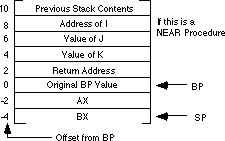
When passing a parameter by value-returned or result, you pass an address
to the procedure, exactly like passing the parameter by reference. The only
difference is that you use a local copy of the variable within the procedure
rather than accessing the variable indirectly through the pointer. The following
implementations for xyz show how to pass I by
value-returned and by result:
; xyz version using Pass by Value-Returned for xyz_i
xyz_i equ 8[bp] ;Use equates so we can reference
xyz_j equ 6[bp] ; symbolic names in the body of
xyz_k equ 4[bp] ; the procedure.
xyz proc near
push bp
mov bp, sp
push ax
push bx
push cx ;Keep local copy here.
mov bx, xyz_i ;Get address of I into BX
mov cx, [bx] ;Get local copy of I parameter.
mov ax, xyz_j ;Get J parameter
add ax, xyz_k ;Add to K parameter
mov cx, ax ;Store result into local copy
mov bx, xyz_i ;Get ptr to I, again
mov [bx], cx ;Store result away.
pop cx
pop bx
pop ax
pop bp
ret 6
xyz endp
There are a couple of unnecessary mov instructions in this code. They are
present only to precisely implement pass by value-returned parameters. It
is easy to improve this code using pass by result parameters. The modified
code is
; xyz version using Pass by Result for xyz_i
xyz_i equ 8[bp] ;Use equates so we can reference
xyz_j equ 6[bp] ; symbolic names in the body of
xyz_k equ 4[bp] ; the procedure.
xyz proc near
push bp
mov bp, sp
push ax
push bx
push cx ;Keep local copy here.
mov ax, xyz_j ;Get J parameter
add ax, xyz_k ;Add to K parameter
mov cx, ax ;Store result into local copy
mov bx, xyz_i ;Get ptr to I, again
mov [bx], cx ;Store result away.
pop cx
pop bx
pop ax
pop bp
ret 6
xyz endp
As with passing value-returned and result parameters in registers, you can
improve the performance of this code using a modified form of pass by value.
Consider the following implementation of xyz:
; xyz version using modified pass by value-result for xyz_i
xyz_i equ 8[bp] ;Use equates so we can reference
xyz_j equ 6[bp] ; symbolic names in the body of
xyz_k equ 4[bp] ; the procedure.
xyz proc near
push bp
mov bp, sp
push ax
mov ax, xyz_j ;Get J parameter
add ax, xyz_k ;Add to K parameter
mov xyz_i, ax ;Store result into local copy
pop ax
pop bp
ret 4 ;Note that we do not pop I parm.
xyz endp
The calling sequence for this code is
push a ;Pass a's value to xyz.
push 3 ;Pass second parameter by val.
push 4 ;Pass third parameter by val.
call xyz
pop a
Note that a pass by result version wouldn't be practical since you have
to push something on the stack to make room for the local copy of I inside
xyz. You may as well push the value of a on entry even though the xyz procedure
ignores it. This procedure pops only four bytes off the stack on exit. This
leaves the value of the I parameter on the stack so that the calling code
can store it away to the proper destination.
procedure swap(name Item1, Item2:integer);
var temp:integer;
begin
temp := Item1;
Item1 := Item2;
Item2 := Temp;
end;
If swap is a near procedure, the 80x86 code for this procedure could look
like the following (note that this code has been slightly optimized and
does not following the exact sequence given above):
; swap- swaps two parameters passed by name on the stack.
; Item1 is passed at address [bp+6], Item2 is passed
; at address [bp+4]
wp textequ <word ptr>
swap_Item1 equ [bp+6]
swap_Item2 equ [bp+4]
swap proc near
push bp
mov bp, sp
push ax ;Preserve temp value.
push bx ;Preserve bx.
call wp swap_Item1 ;Get adrs of Item1.
mov ax, [bx] ;Save in temp (AX).
call wp swap_Item2 ;Get adrs of Item2.
xchg ax, [bx] ;Swap temp <-> Item2.
call wp swap_Item1 ;Get adrs of Item1.
mov [bx], ax ;Save temp in Item1.
pop bx ;Restore bx.
pop ax ;Restore ax.
ret 4 ;Return and pop Item1/2.
swap endp
Some sample calls to swap follow:
; swap(A[i], i) -- 8086 version.
lea ax, thunk1
push ax
lea ax, thunk2
push ax
call swap
; swap(A[i],i) -- 80186 & later version.
push offset thunk1
push offset thunk2
call swap
.
.
.
; Note: this code assumes A is an array of two byte integers.
thunk1 proc near
mov bx, i
shl bx, 1
lea bx, A[bx]
ret
thunk1 endp
thunk2 proc near
lea bx, i
ret
thunk2 endp
The code above assumes that the thunks are near procs that reside in the
same segment as the swap routine. If the thunks are far procedures the caller
must pass far addresses on the stack and the swap routine must manipulate
far addresses. The following implementation of swap, thunk1, and thunk2
demonstrate this.
; swap- swaps two parameters passed by name on the stack.
; Item1 is passed at address [bp+10], Item2 is passed
; at address [bp+6]
swap_Item1 equ [bp+10]
swap_Item2 equ [bp+6]
dp textequ <dword ptr>
swap proc far
push bp
mov bp, sp
push ax ;Preserve temp value.
push bx ;Preserve bx.
push es ;Preserve es.
call dp swap_Item1 ;Get adrs of Item1.
mov ax, es:[bx] ;Save in temp (AX).
call dp swap_Item2 ;Get adrs of Item2.
xchg ax, es:[bx] ;Swap temp <-> Item2.
call dp swap_Item1 ;Get adrs of Item1.
mov es:[bx], ax ;Save temp in Item1.
pop es ;Restore es.
pop bx ;Restore bx.
pop ax ;Restore ax.
ret 8 ;Return and pop Item1, Item2.
swap endp
Some sample calls to swap follow:
; swap(A[i], i) -- 8086 version.
mov ax, seg thunk1
push ax
lea ax, thunk1
push ax
mov ax, seg thunk2
push ax
lea ax, thunk2
push ax
call swap
; swap(A[i],i) -- 80186 & later version.
push seg thunk1
push offset thunk1
push seg thunk2
push offset thunk2
call swap
.
.
.
; Note: this code assumes A is an array of two byte integers.
; Also note that we do not know which segment(s) contain
; A and I.
thunk1 proc far
mov bx, seg A ;Need to return seg A in ES.
push bx ;Save for later.
mov bx, seg i ;Need segment of I in order
mov es, bx ; to access it.
mov bx, es:i ;Get I's value.
shl bx, 1
lea bx, A[bx]
pop es ;Return segment of A[I] in es.
ret
thunk1 endp
thunk2 proc near
mov bx, seg i ;Need to return I's seg in es.
mov es, bx
lea bx, i
ret
thunk2 endp
Passing parameters by lazy evaluation is left for the programming projects.